Physical Address
304 North Cardinal St.
Dorchester Center, MA 02124
| Patient History | |
| Complaints |
|
| Physical Examination | |
| Screening |
|
| Range-of-Motion and Strength Assessment |
|
| Other Assessments |
|
| Special Tests |
|
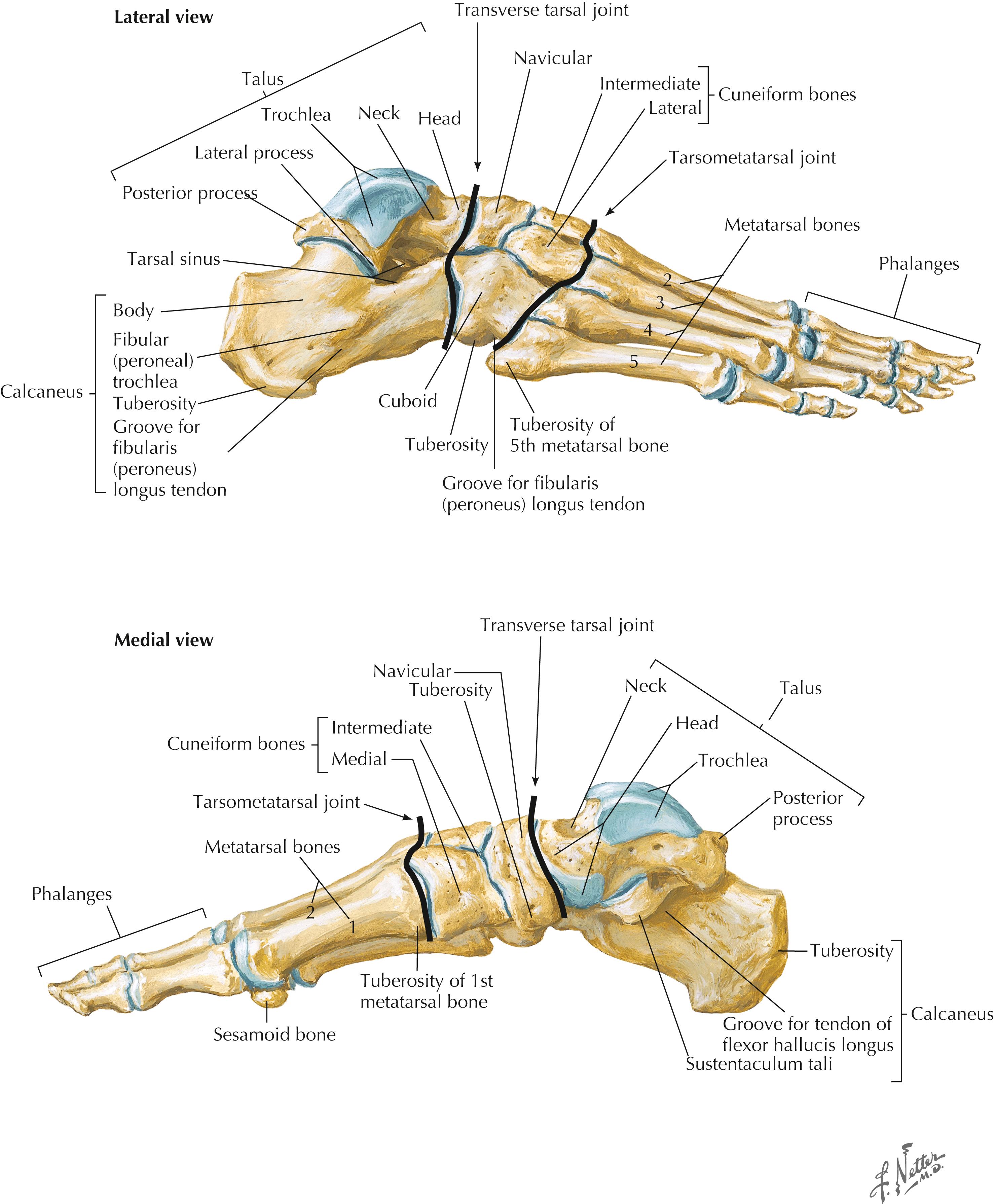
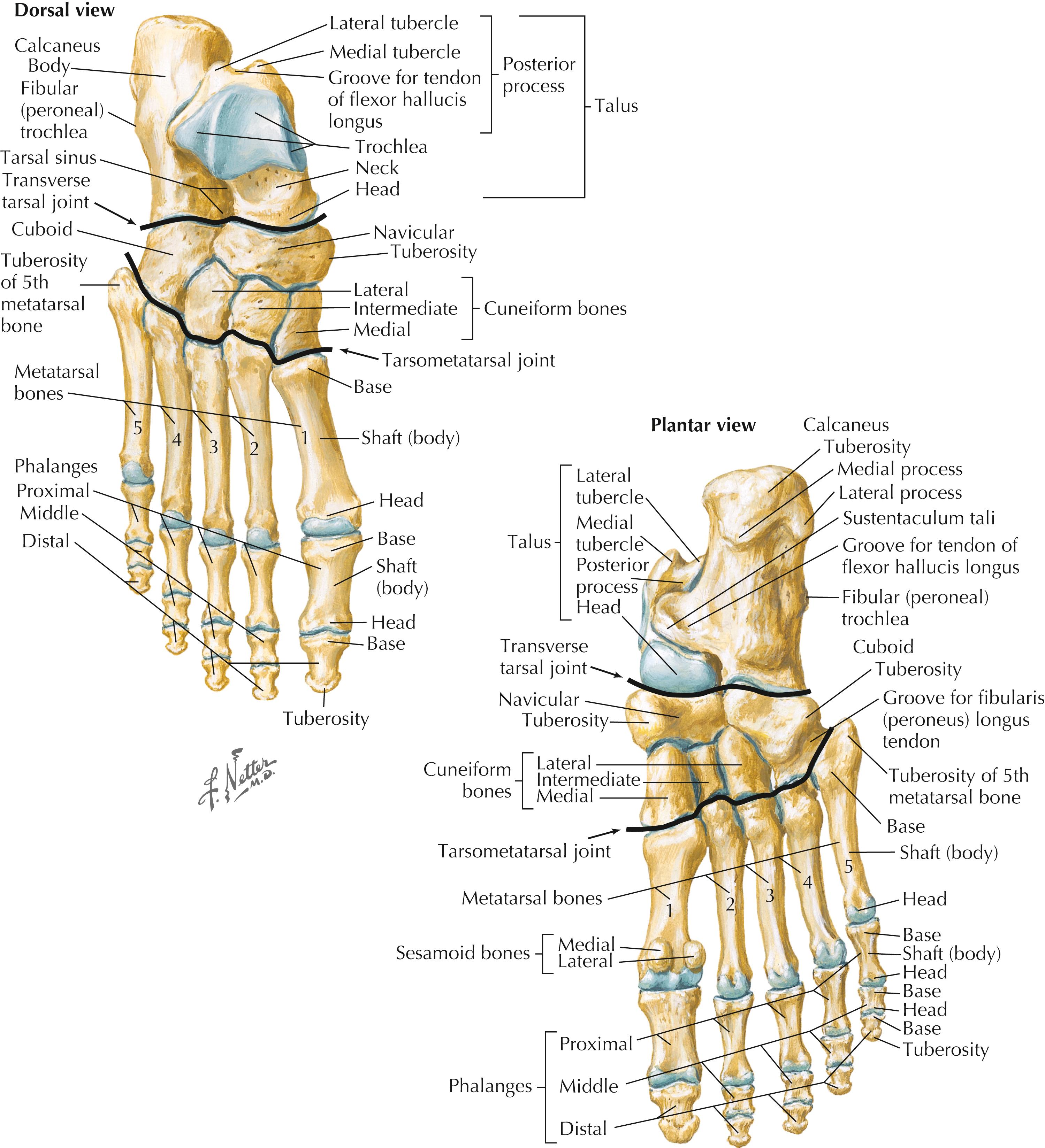

| Joint | Type and Classification | Closed Packed Position | Capsular Pattern |
|---|---|---|---|
| Talocrural | Synovial: hinge | Dorsiflexion | Plantarflexion slightly more limited than dorsiflexion |
| Distal tibiofibular | Syndesmosis | Not available | Not available |
| Subtalar | Synovial: plane | Supination | Inversion greatly restricted; eversion not restricted |
| Talocalcaneonavicular | Synovial: plane | Supination | Supination more limited than pronation |
| Calcaneocuboid | Synovial: plane | Supination | |
| Transverse tarsal | Synovial: plane | Supination | |
| Tarsometatarsal | Synovial: plane | Supination | Not available |
| Metatarsophalangeal (MTP) | Synovial: condyloid | Extension | Great toe: extension more limited than flexion MTP joints 2 to 5: variable |
| Interphalangeal (IP) | Synovial: hinge | Extension | Extension more limited than flexion |
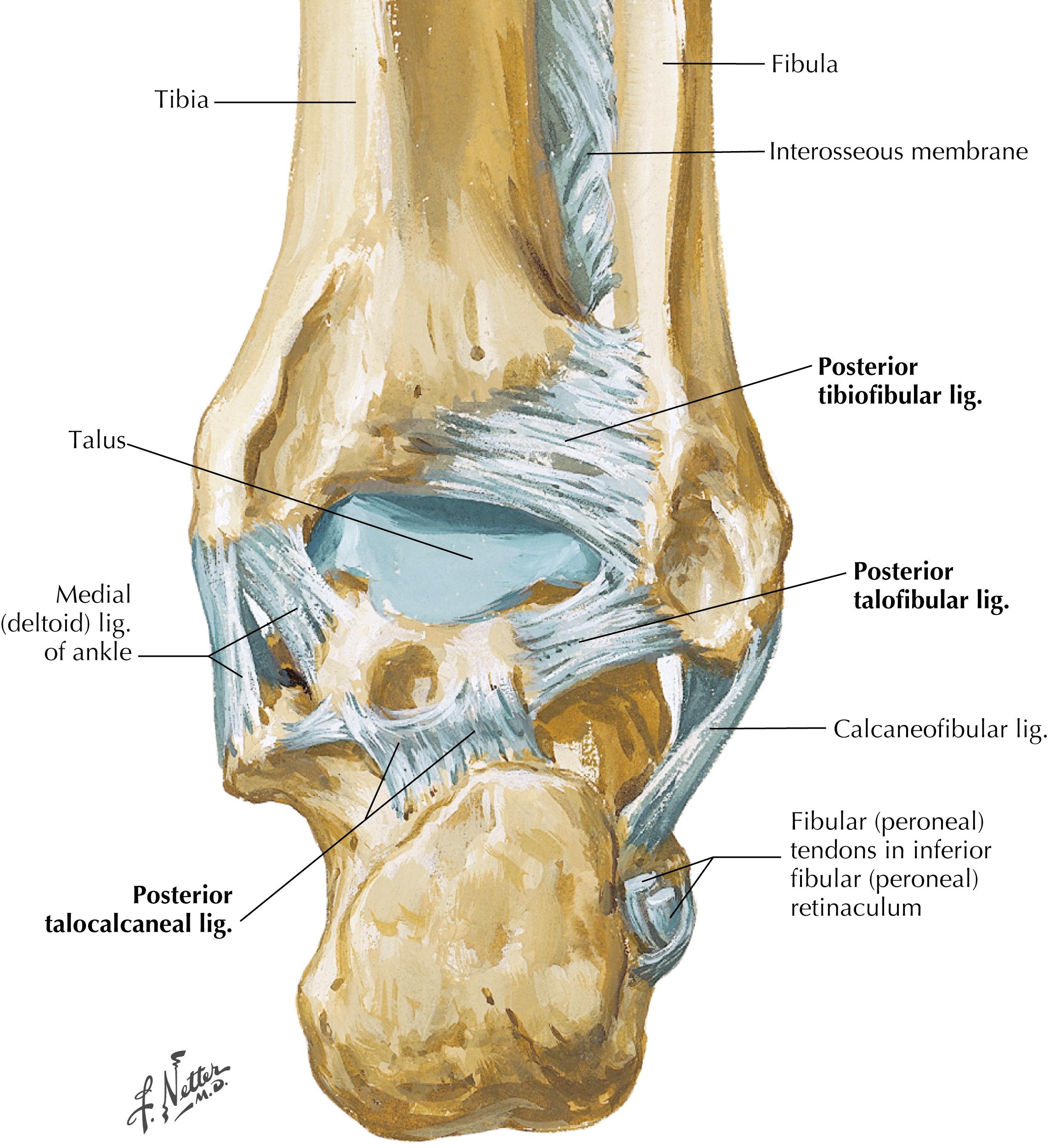
| Ligaments | Attachments | Function |
|---|---|---|
| Posterior talocalcaneal | Superior body of calcaneus to posterior process of talus | Limits posterior separation of talus from calcaneus |
| Posterior tibiofibular | Distal posterior tibia to distal posterior fibula | Maintains distal tibiofibular joint |
| Posterior talofibular | Posterior talus to posterior lateral malleolus | Limits separation of fibula from talus |
| Interosseous membrane | Continuous connection between tibia and fibula | Reinforces approximation between tibia and fibula |
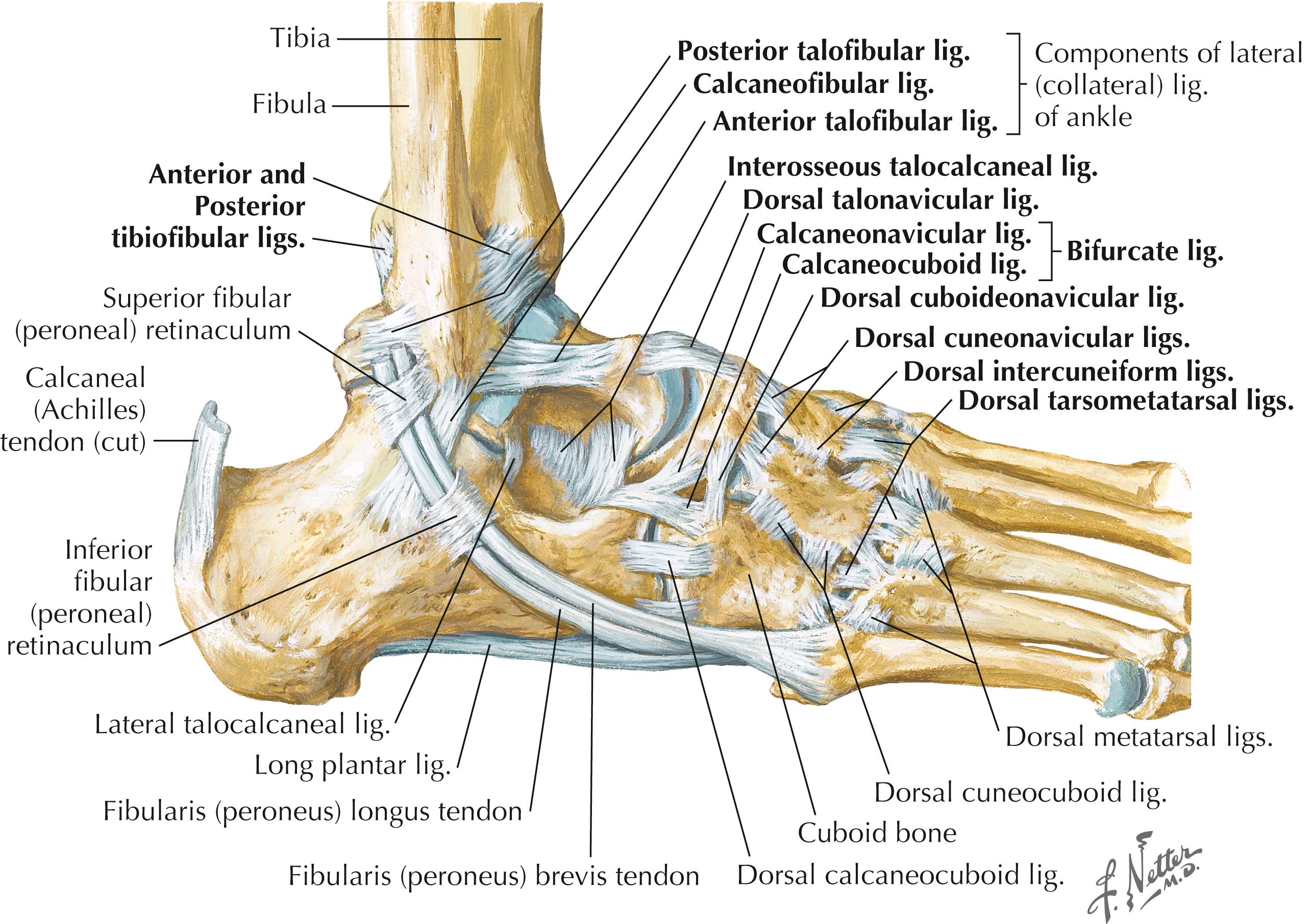
| Ligaments | Attachments | Function |
|---|---|---|
| Anterior tibiofibular | Anterior aspect of lateral malleolus to inferior border of medial tibia | Reinforces anterior tibiofibular joint |
| Lateral collateral Posterior talofibular Calcaneofibular Anterior talofibular |
Lateral malleolus to lateral talus Lateral malleolus to lateral calcaneus Lateral malleolus to talus |
Limits ankle inversion |
| Interosseous talocalcaneal | Inferior aspect of talus to superior aspect of calcaneus | Limits separation of talus from calcaneus |
| Dorsal talonavicular | Dorsal aspect of talus to dorsal aspect of navicular | Limits separation of navicular from talus |
| Bifurcate Calcaneonavicular Calcaneocuboid |
Distal calcaneus to proximal navicular Distal calcaneus to proximal cuboid |
Limits separation of navicular and cuboid from calcaneus |
| Dorsal cubonavicular | Lateral aspect of cuboid to dorsal aspect of navicular | Limits separation of navicular from cuboid |
| Dorsal cuneonavicular | Navicular to three cuneiforms | Limits separation of cuneiforms from navicular |
| Dorsal intercuneiform | Joining of three cuneiforms | Limits separation of cuneiforms |
| Dorsal tarsometatarsal | Dorsal tarsal bones to corresponding metatarsal bones | Reinforces tarsometatarsal joints |
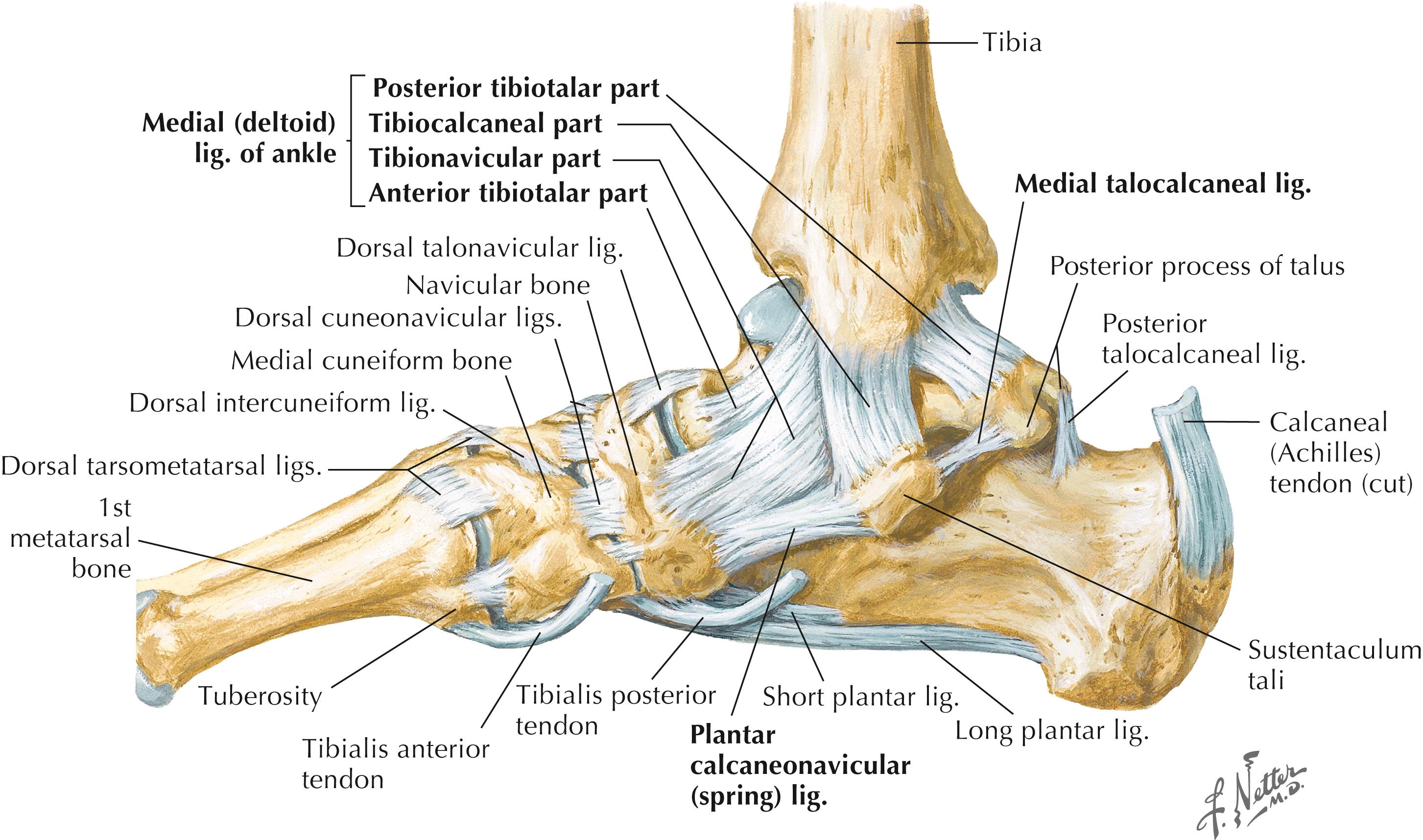
| Ligaments | Attachments | Function |
|---|---|---|
| Medial (deltoid) | ||
| Posterior tibiotalar | Medial malleolus to medial talus | Limits ankle eversion |
| Tibiocalcaneal | Anterior distal medial malleolus to sustentaculum tali | |
| Tibionavicular | Medial malleolus to proximal aspect of navicular | |
| Anterior tibiotalar | Medial malleolus to talus | |
| Medial talocalcaneal | Sustentaculum tali to talus | Limits posterior separation of talus on calcaneus |
| Plantar calcaneonavicular (spring) | Sustentaculum tali to posteroinferior navicular | Maintains longitudinal arch of foot |
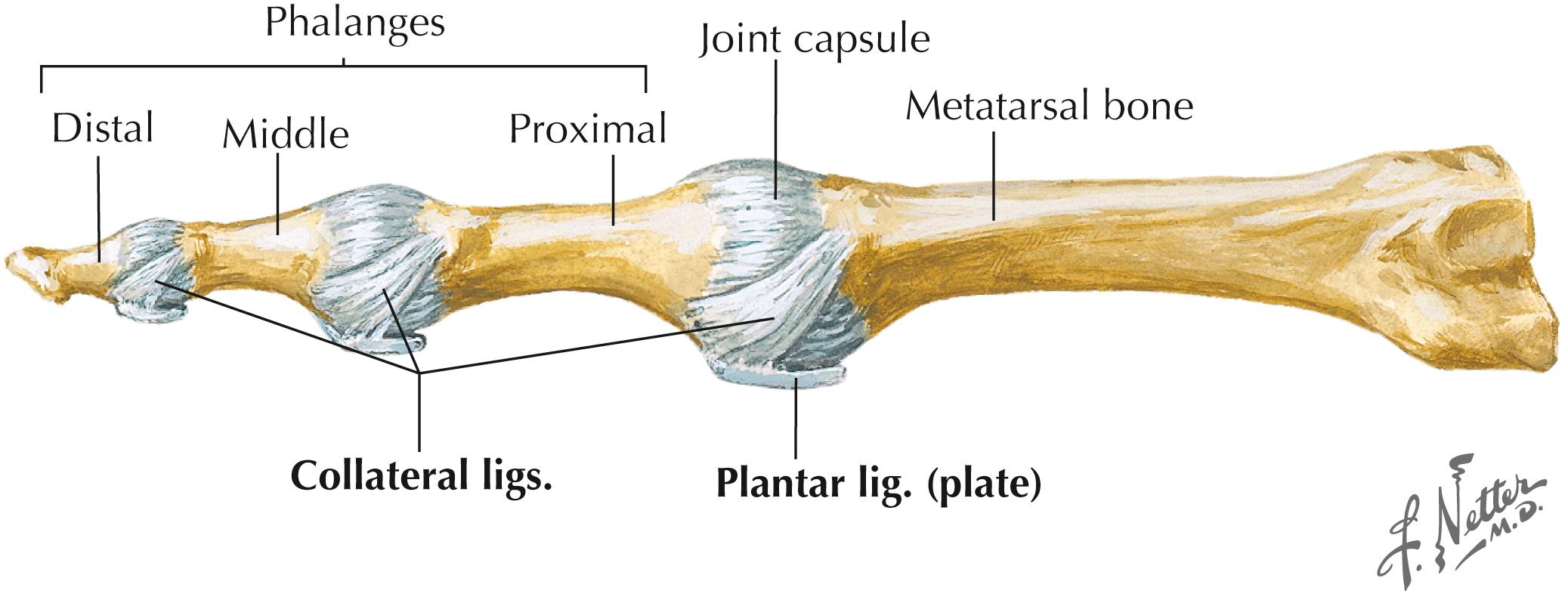
| Ligaments | Attachments | Function |
|---|---|---|
| Long plantar | Plantar of calcaneus to cuboid | Maintains arches of foot |
| Plantar calcaneocuboid (short plantar) | Anteroinferior aspect of calcaneus to inferior aspect of cuboid | Maintains arches of foot |
| Plantar calcaneonavicular (spring) | Sustentaculum tali to posteroinferior aspect of talus | Maintains longitudinal arch of foot |
| Plantar cubonavicular | Inferior navicular to inferomedial cuboid | Limits separation of cuboid from navicular and supports arch |
| Plantar tarsometatarsal | Connects metatarsals 1 to 5 to corresponding tarsal on plantar aspect | Limits separation of metatarsals from corresponding tarsal bones |
| Collateral | Distal aspect of proximal phalanx to proximal aspect of distal phalanx | Reinforces capsule of IP joints |
| Plantar plate | Thickening of plantar aspect of joint capsule | Reinforces plantar aspect of IP joint |
| Deep transverse metatarsal | MTP joints on plantar aspect | Limits separation of MTP joints |
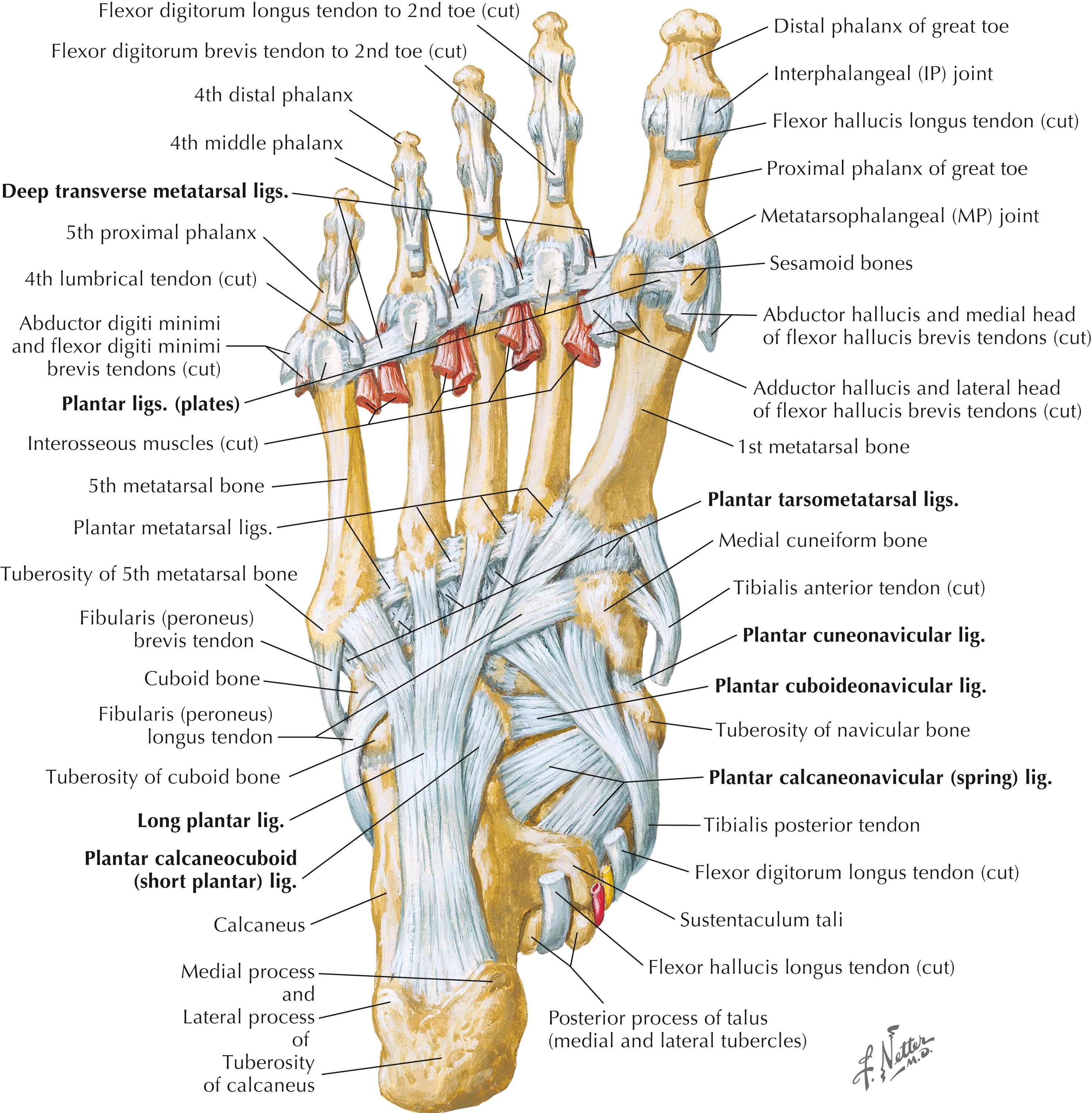
| Muscles | Proximal Attachments | Distal Attachments | Nerve and Segmental Level | Action |
|---|---|---|---|---|
| Gastrocnemius | Lateral head: lateral femoral condyle Medial head: popliteal surface of femur |
Posterior aspect of calcaneus | Tibial nerve (S1, S2) | Plantarflexes ankle and flexes knee |
| Soleus | Posterior aspect of head of fibula, fibular soleal line, and medial aspect of tibia | Posterior aspect of calcaneus | Tibial nerve (S1, S2) | Plantarflexes ankle |
| Fibularis longus | Superolateral surface of fibula | Base of first metatarsal and medial cuneiform | Superficial fibular nerve (L5, S1, S2) | Everts foot and assists in plantarflexion |
| Fibularis brevis | Distal aspect of fibula | Tuberosity of base of fifth metatarsal | Superficial fibular nerve (L5, S1, S2) | Everts foot and assists in plantarflexion |
| Fibularis tertius | Anteroinferior aspect of fibula and interosseus membrane | Base of fifth metatarsal | Deep fibular nerve (L5, S1) | Dorsiflexes ankle and everts foot |
| Extensor digitorum longus | Lateral condyle of tibia, medial surface of fibula | Middle and distal phalanges of digits 2 to 5 | Deep fibular nerve (L5, S1) | Extends digits 2 to 5 and assists with ankle dorsiflexion |
| Extensor hallucis longus | Anterior fibula and interosseous membrane | Dorsal base of distal phalanx of great toe | Deep fibular nerve (L5, S1) | Extends great toe and assists with ankle dorsiflexion |
| Extensor digitorum brevis | Superolateral aspect of calcaneus, extensor retinaculum | Dorsal base of middle phalanx of digits 2 to 5 | Deep fibular nerve (L5, S1) | Extends digits 2 to 4 at MTP joints |
| Tibialis anterior | Lateral condyle and anterior surface of tibia | Inferomedial aspect of medial cuneiform and base of first metatarsal | Deep fibular nerve (L4, L5) | Ankle dorsiflexion and foot inversion |

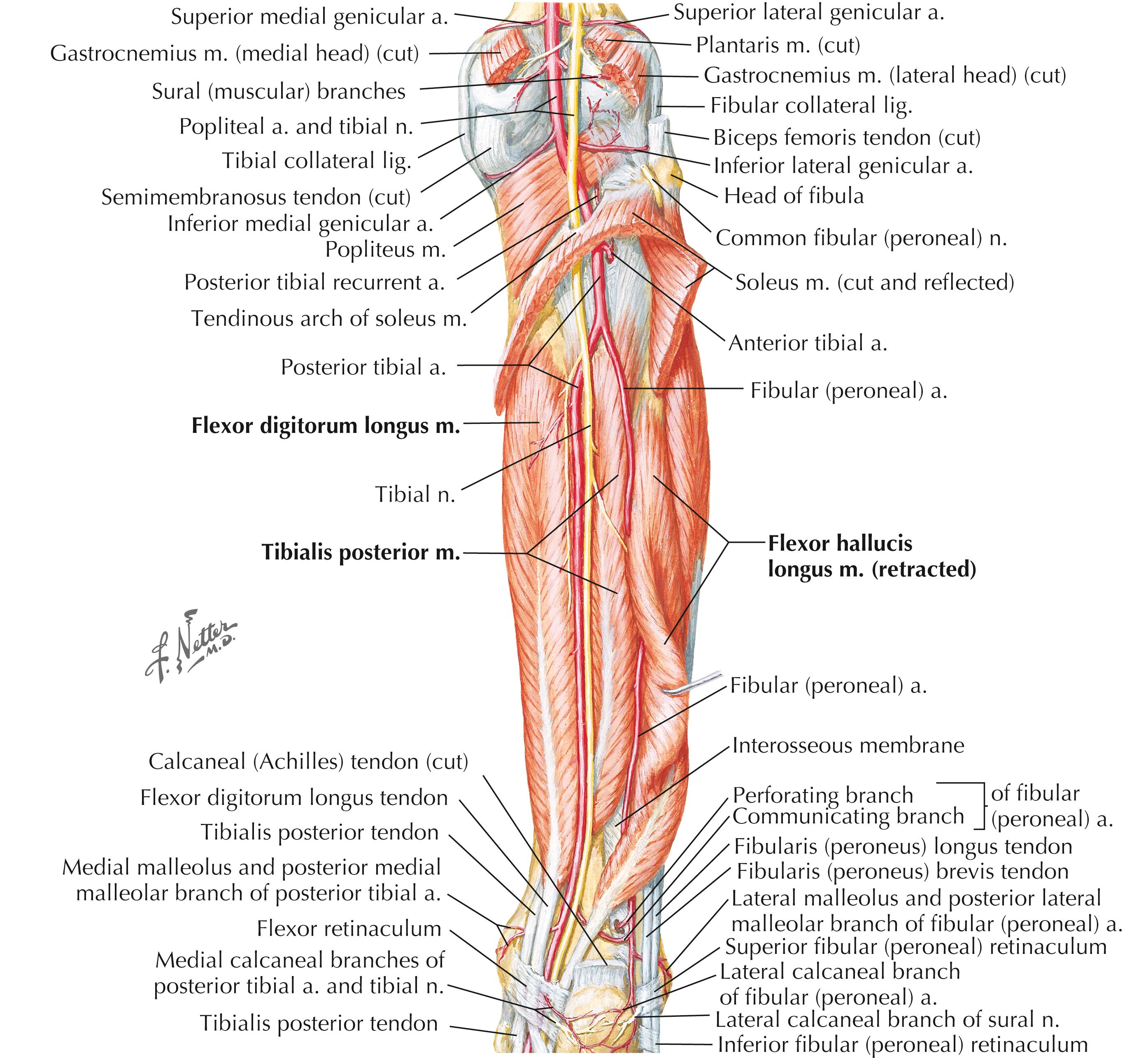
| Muscles | Proximal Attachments | Distal Attachments | Nerve and Segmental Level | Action |
|---|---|---|---|---|
| Tibialis posterior | Interosseous membrane, posteroinferior aspect of tibia, and posterior fibula | Navicular tuberosity, cuneiform, cuboid, and bases of metatarsals 2 to 4 | Tibial nerve (L4, L5) | Plantarflexes ankle and inverts foot |
| Flexor hallucis longus | Posteroinferior fibula and interosseous membrane | Base of distal phalanx of great toe | Tibial nerve (S2, S3) | Flexes great toe and assists with ankle plantarflexion |
| Flexor digitorum longus | Posteroinferior tibia | Bases of distal phalanges 2 to 5 | Tibial nerve (S2, S3) | Flexes lateral four digits, plantarflexes ankle, supports longitudinal arch of foot |
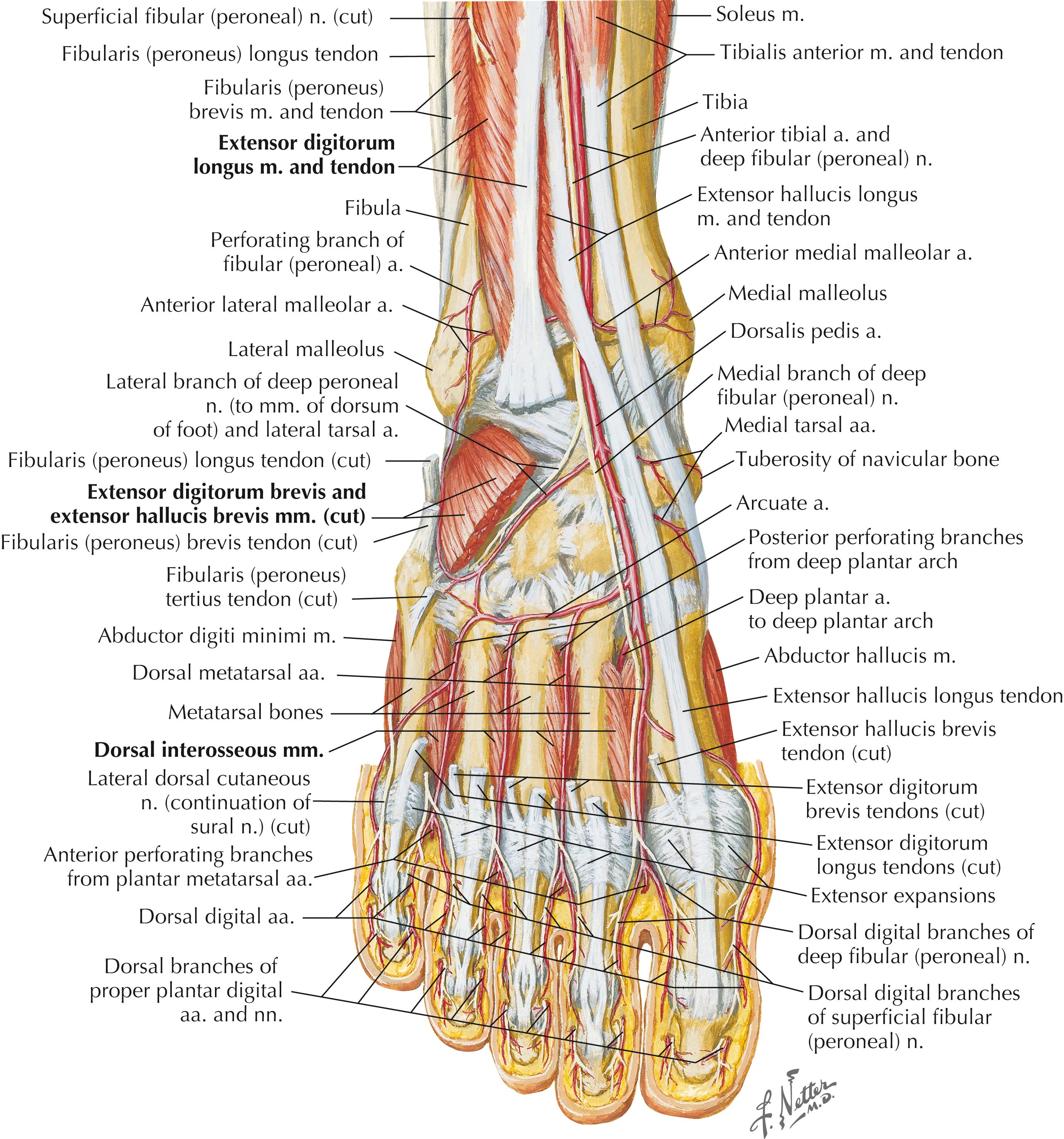
| Muscles | Proximal Attachments | Distal Attachments | Nerve and Segmental Level | Action |
|---|---|---|---|---|
| Extensor digitorum brevis | Superolateral aspect of calcaneus and extensor retinaculum | Dorsal base of middle phalanx of digits 2 to 5 | Deep fibular nerve (L5, S1) | Extends digits 2 to 4 at MTP joints |
| Extensor hallucis brevis | Superolateral aspect of calcaneus and extensor retinaculum | Dorsal base of proximal phalanx of great toe | Deep fibular nerve (L5, S1) | Extends great toe at MTP joints |
| Dorsal interossei | Sides of metatarsals 1 to 5 | First: medial aspect of proximal phalanx of second digit Second to fourth: lateral aspect of digits 2 to 4 |
Lateral plantar nerve (S2, S3) | Abducts digits 2 to 4 and flexes MTP joints |
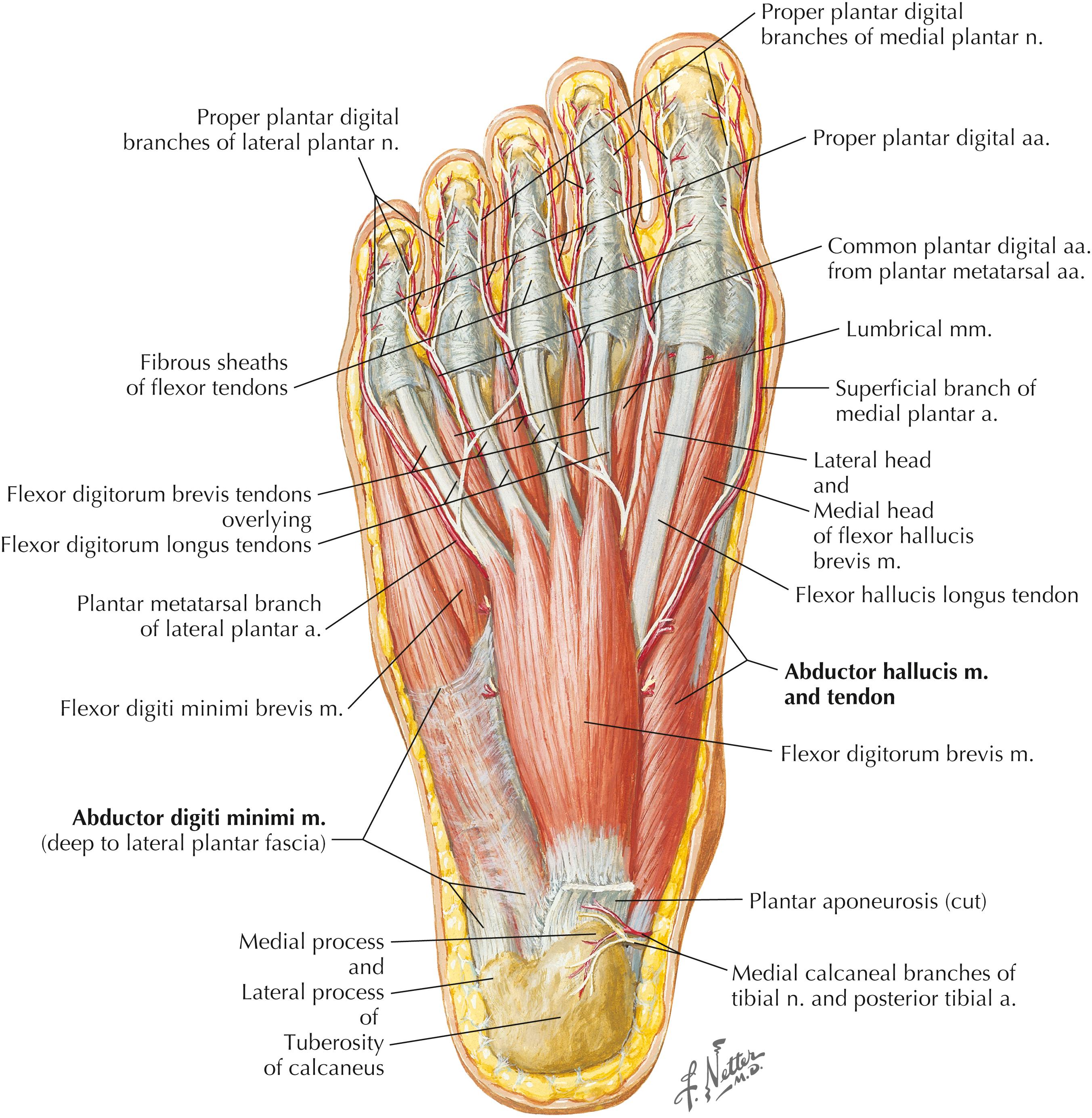
| Muscles | Proximal Attachments | Distal Attachments | Nerve and Segmental Level | Action |
|---|---|---|---|---|
| Abductor hallucis longus | Medial calcaneal tuberosity, flexor retinaculum, and plantar aponeurosis | Base of proximal phalanx of first digit | Medial plantar nerve (S2, S3) | Abducts and flexes great toe |
| Flexor digitorum brevis | Medial calcaneal tuberosity and plantar aponeurosis | Sides of middle phalanges of digits 2 to 5 | Medial plantar nerve (S2, S3) | Flexes digits 2 to 5 |
| Abductor digiti minimi | Medial and lateral calcaneal tuberosities | Lateral aspect of base of proximal phalanx of fifth metatarsal | Lateral plantar nerve (S2, S3) | Abducts and flexes fifth digit |
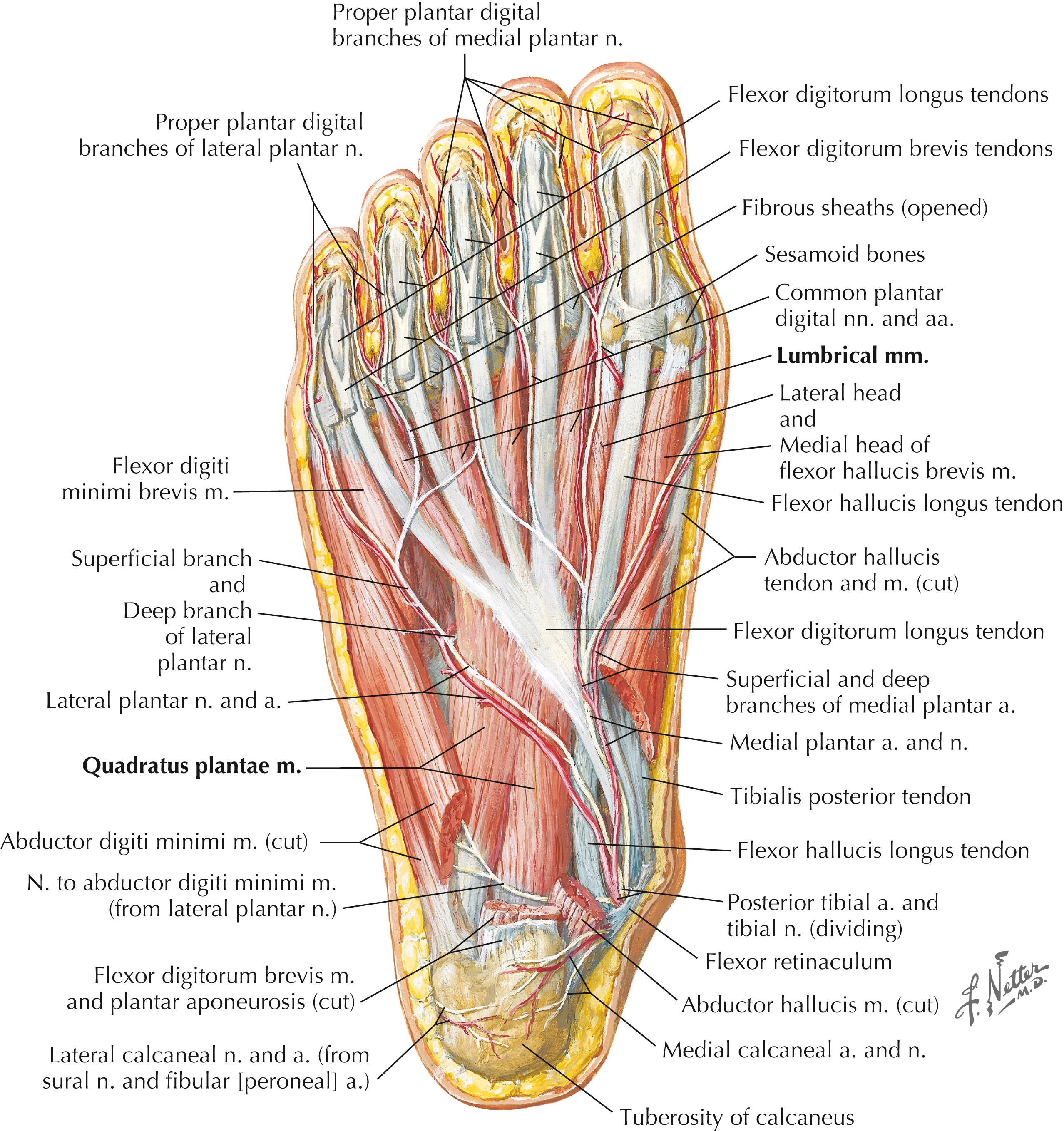
| Muscles | Proximal Attachments | Distal Attachments | Nerve and Segmental Level | Action |
|---|---|---|---|---|
| Lumbricals | Tendons of flexor digitorum longus | Medial aspect of expansion over lateral four digits | Lateral three: lateral plantar nerve (S2, S3) Medial one: medial plantar nerve (S2, S3) |
Flexes proximal phalanges and extends middle and distal phalanges of digits 2 to 5 |
| Quadratus plantae | Medial and plantar aspect of calcaneus | Posterolateral aspect of tendon of flexor digitorum longus | Lateral plantar nerve (S2, S3) | Assists in flexing digits 2 to 5 |
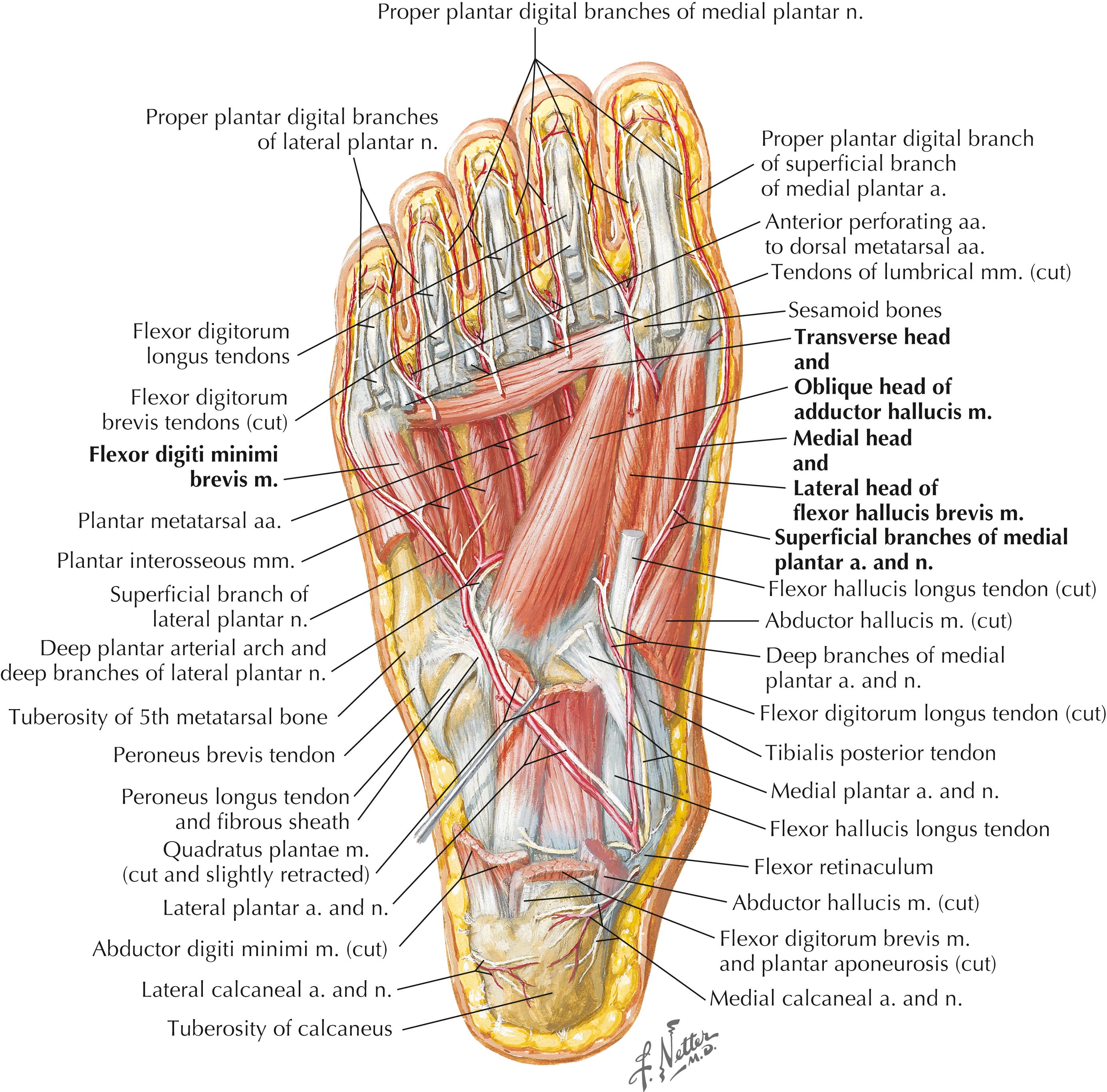
| Muscles | Proximal Attachments | Distal Attachments | Nerve and Segmental Level | Action |
|---|---|---|---|---|
| Flexor digiti minimi brevis | Base of fifth metatarsal | Base of proximal phalanx of fifth metatarsal | Superficial branch of lateral plantar nerve | Flexes proximal phalanx of fifth digit |
| Adductor hallucis (transverse head) | Plantar ligaments of MTP joints | Lateral base of proximal phalanx of great toe | Deep branch of lateral plantar nerve (S2, S3) | Adducts great toe |
| Adductor hallucis (oblique head) | Bases of metatarsals 2 to 4 | |||
| Flexor hallucis brevis | Plantar cuboid and lateral cuneiforms | Sides of proximal phalanx of great toe | Medial plantar nerve (S2, S3) | Flexes proximal phalanx of great toe |
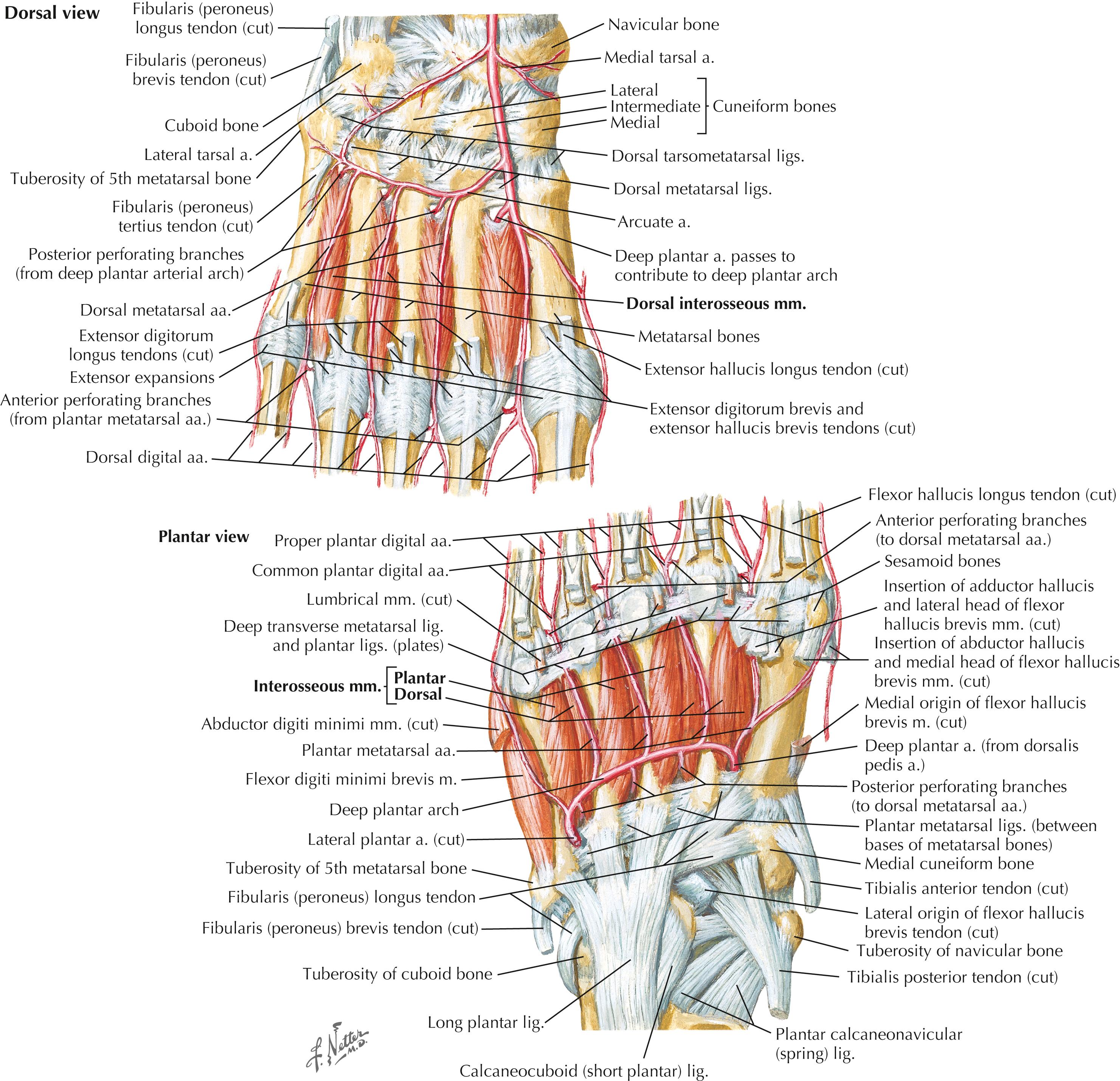
| Muscles | Proximal Attachments | Distal Attachments | Nerve and Segmental Level | Action |
|---|---|---|---|---|
| Plantar interosseous | Bases of metatarsals 3 to 5 | Medial bases of proximal phalanges 3 to 5 | Lateral plantar nerve (S2, S3) | Adducts digits 2 to 4 and flexes MTP joints |
| Dorsal interosseous | Sides of metatarsals 1 to 5 | First: medial aspect of proximal phalanx of second digit Second to fourth: Lateral aspect of digits 2 to 4 |
Lateral plantar nerve (S2, S3) | Abducts digits 2 to 4 and flexes MTP joints |
Become a Clinical Tree membership for Full access and enjoy Unlimited articles
If you are a member. Log in here